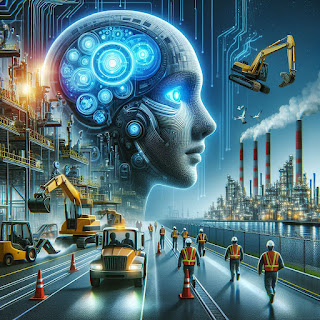The Impact of Artificial Intelligence Evolution on Occupational Safety, Health, and Environment in the Workplace
The ongoing evolution of artificial intelligence (AI) technologies has catalyzed significant transformations across diverse industries, reshaping the landscape of work environments. This thesis investigates the intricate interplay between AI advancement and its multifaceted influence on occupational safety, health, and environmental sustainability within contemporary workplaces.
The integration of AI systems, ranging from machine learning algorithms to robotics, presents both opportunities and challenges in the realm of occupational safety. Through the analysis of various case studies and empirical evidence, this research aims to delineate the mechanisms by which AI contributes to enhancing workplace safety measures. Automation and predictive analytics enable proactive hazard identification, fostering preemptive interventions to mitigate risks and enhance overall safety protocols. Additionally, AI-powered robotics and wearable devices offer innovative solutions for hazardous tasks, reducing human exposure to potentially dangerous environments.
However, amidst these advancements, concerns arise regarding the implications of AI on employee health and well-being. Prolonged interactions with AI systems and increased automation may lead to issues related to job displacement, psychological stress, and potential ergonomic challenges. This study investigates these potential health ramifications, seeking to identify strategies to proactively address and mitigate these emerging concerns.
Furthermore, the integration of AI technologies in workplaces prompts a reevaluation of environmental sustainability practices. AI-driven optimization in resource allocation, energy management, and waste reduction presents opportunities for significant ecological impact. Yet, the environmental footprint of AI itself, from manufacturing to disposal, necessitates a critical examination of its net environmental effects. This research endeavors to evaluate the broader environmental implications of AI adoption in workplaces and proposes strategies for achieving a balance between technological advancement and environmental stewardship.
By synthesizing findings from empirical studies, surveys, and existing literature, this thesis aims to provide a comprehensive framework for stakeholders to navigate the evolving landscape of AI integration in workplaces. Through the identification of potential risks, delineation of opportunities, and formulation of adaptable frameworks, this research seeks to inform policymakers, industry leaders, and practitioners. Ultimately, this study strives to facilitate informed decision-making processes to ensure the harmonious integration of AI technologies while safeguarding occupational safety, preserving employee health, and promoting environmental sustainability in the workplace.
Η συνεχής εξέλιξη των τεχνολογιών τεχνητής νοημοσύνης (AI) έχει καταλύσει σημαντικούς μετασχηματισμούς σε διάφορους κλάδους, αναδιαμορφώνοντας το τοπίο των εργασιακών περιβαλλόντων. Αυτή η διατριβή διερευνά την περίπλοκη αλληλεπίδραση μεταξύ της εξέλιξης της τεχνητής νοημοσύνης και της πολύπλευρης επιρροής της στην επαγγελματική ασφάλεια, υγεία και περιβαλλοντική βιωσιμότητα στους σύγχρονους χώρους εργασίας.
Η ενοποίηση συστημάτων AI, που κυμαίνονται από αλγόριθμους μηχανικής μάθησης έως ρομποτική, παρουσιάζει ευκαιρίες και προκλήσεις στον τομέα της επαγγελματικής ασφάλειας. Μέσω της ανάλυσης διαφόρων περιπτωσιολογικών μελετών και εμπειρικών στοιχείων, αυτή η έρευνα στοχεύει να οριοθετήσει τους μηχανισμούς με τους οποίους η τεχνητή νοημοσύνη συμβάλλει στην ενίσχυση των μέτρων ασφάλειας στο χώρο εργασίας. Η αυτοματοποίηση και οι προγνωστικές αναλύσεις επιτρέπουν τον προληπτικό εντοπισμό κινδύνων, ενθαρρύνοντας προληπτικές παρεμβάσεις για τον μετριασμό των κινδύνων και τη βελτίωση των συνολικών πρωτοκόλλων ασφάλειας. Επιπλέον, η ρομποτική και οι φορητές συσκευές με τεχνητή νοημοσύνη προσφέρουν καινοτόμες λύσεις για επικίνδυνες εργασίες, μειώνοντας την ανθρώπινη έκθεση σε δυνητικά επικίνδυνα περιβάλλοντα. Ωστόσο, εν μέσω αυτών των εξελίξεων, προκύπτουν ανησυχίες σχετικά με τις επιπτώσεις της τεχνητής νοημοσύνης στην υγεία και την ευημερία των εργαζομένων. Οι παρατεταμένες αλληλεπιδράσεις με συστήματα τεχνητής νοημοσύνης και η αυξημένη αυτοματοποίηση μπορεί να οδηγήσουν σε ζητήματα που σχετίζονται με μετατόπιση εργασίας, ψυχολογικό στρες και πιθανές εργονομικές προκλήσεις. Αυτή η μελέτη διερευνά αυτές τις πιθανές επιπτώσεις στην υγεία, επιδιώκοντας να εντοπίσει στρατηγικές για την προληπτική αντιμετώπιση και τον μετριασμό αυτών των αναδυόμενων ανησυχιών. Επιπλέον, η ενσωμάτωση τεχνολογιών τεχνητής νοημοσύνης στους χώρους εργασίας προτρέπει την επανεκτίμηση των πρακτικών περιβαλλοντικής βιωσιμότητας. Η βελτιστοποίηση με γνώμονα την τεχνητή νοημοσύνη στην κατανομή πόρων, τη διαχείριση ενέργειας και τη μείωση των αποβλήτων παρουσιάζει ευκαιρίες για σημαντικές οικολογικές επιπτώσεις. Ωστόσο, το περιβαλλοντικό αποτύπωμα της ίδιας της τεχνητής νοημοσύνης, από την κατασκευή μέχρι την απόρριψη, απαιτεί μια κριτική εξέταση των καθαρών περιβαλλοντικών επιπτώσεών της. Αυτή η έρευνα προσπαθεί να αξιολογήσει τις ευρύτερες περιβαλλοντικές επιπτώσεις της υιοθέτησης της τεχνητής νοημοσύνης στους χώρους εργασίας και προτείνει στρατηγικές για την επίτευξη ισορροπίας μεταξύ της τεχνολογικής προόδου και της περιβαλλοντικής διαχείρισης. Με τη σύνθεση ευρημάτων από εμπειρικές μελέτες, έρευνες και υπάρχουσα βιβλιογραφία, αυτή η διατριβή στοχεύει να παρέχει ένα ολοκληρωμένο πλαίσιο για τους ενδιαφερόμενους για να περιηγηθούν στο εξελισσόμενο τοπίο της ενσωμάτωσης της τεχνητής νοημοσύνης στους χώρους εργασίας. Μέσω του εντοπισμού πιθανών κινδύνων, της οριοθέτησης ευκαιριών και της διαμόρφωσης προσαρμοστικών πλαισίων, αυτή η έρευνα επιδιώκει να ενημερώσει τους υπεύθυνους χάραξης πολιτικής, τους ηγέτες του κλάδου και τους επαγγελματίες.Addressing these risks involves proactive measures such as robust training programs, thorough risk assessments, regular evaluations, and creating a culture that prioritizes safety, ethical AI development, and environmental sustainability in the workplace.



Σχόλια
Δημοσίευση σχολίου